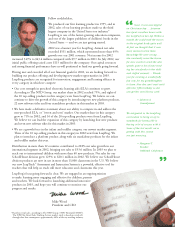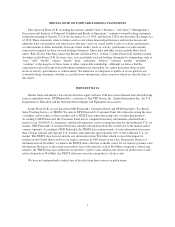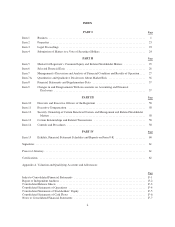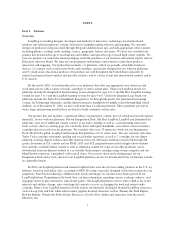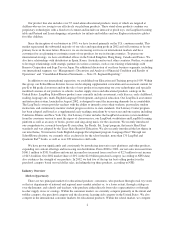LeapFrog 2002 Annual Report Download - page 12
Download and view the complete annual report
Please find page 12 of the 2002 LeapFrog annual report below. You can navigate through the pages in the report by either clicking on the pages listed below, or by using the keyword search tool below to find specific information within the annual report.educational products, we are expanding our line of Quantum Leap branded products, designed for older children.
In 2001, we launched our iQuest handheld device initially for students in the 6th through 8th grades and in
November 2002, we launched our Quantum Pad platform for 3rd through 5th grade students. We also expanded
content for our iQuest handheld for 5th through 8th grade students and for high school students as well. In
addition, to broaden further our product offerings, we also increased substantially our products designed for
infants, toddlers and preschoolers, with new stand-alone products such as the LeapStart learning table, Pretend
and Learn shopping cart and Leap’s Phonics Railroad. We believe that by establishing an early association
between LeapFrog branded products and quality educational tools in the minds of parents, we will be able to
generate repeat purchases of our products by parents and others as the children for whom they buy progress from
preschool, to grade school, to middle school and beyond.
Developing Additional Distribution Channels
We believe we are not limited to traditional toy and other large retailers for distribution of our products.
Since much of our content is in book form, we plan to increase distribution of our content through bookstores.
We are also increasing distribution of our platforms and related content through electronics retailers, office
supply stores and other specialty retailers. In 2002, we expanded our distribution to these retailers.
Expanding Our Presence in International Markets
We have already created localized versions of some of our products for international markets, but we have
only recently begun to focus on these markets. We launched our first international subsidiary in the United
Kingdom in 2000. Our international net sales were approximately $54 million in 2002. We expect our sales from
international markets to grow significantly and to constitute a larger portion of our sales in the future. We plan to
penetrate international consumer markets by establishing overseas subsidiaries and using a combination of direct
sales to retailers and distribution arrangements. We may also enter into strategic relationships to meet the
challenges of providing localized content in different countries. For example, in January 2002 we announced a
strategic relationship with Benesse Corporation to use our products as part of their supplemental education
program in Japan, as well as an agreement with Sega Toys to expand our presence in the Japanese consumer
market. We believe international markets provide opportunities to sell local-language versions of our products as
well as English-language versions marketed as tools for learning English as a foreign language.
Expanding Sales of Our SchoolHouse Division
We intend to increase significantly our penetration of the school market by combining research-based
instruction principles with our engaging, interactive technologies to create products designed specifically for the
classroom. Our SchoolHouse division, which is a part of our Education and Training group, targets educational
institutions and teacher supply stores and catalogs. Our Literacy Center, designed to help build reading skills
using specifically developed products as well as a SchoolHouse version of our popular LeapPad platform, has
been adopted and listed as an approved standards-based supplemental reading curriculum for certain grade levels
by seven states and one region, including California, Illinois and New York City. With our LeapTrack
assessment and instructional management system, launched in August 2002, teachers are able to assess each
student’s strengths and weaknesses relative to skills and state standards and track performance over time. In
addition, the teacher can prescribe individualized instructional content to meet the specific needs of each student.
In October 2002, we introduced the Ready, Set, Leap! curriculum program for the pre-K market. Using this
comprehensive program, schools, Head Start and childcare programs will be able to provide a multisensory
learning experience that meets state standards. In December 2002, we launched the final theme in our nine-
theme, 36 interactive book English Language Development program. We also expanded significantly our direct
sales force to reach more classrooms across the United States. In the future, our Education and Training group
may seek to develop products for the adult learning and patient education markets based on our core
technologies.
The Educational Foundation of Our Products
We believe that sound educational principles are at the core of the value of our brands and products. Our
team of in-house educational experts in the SchoolHouse division, assisted by our Education Advisory Board,
7


